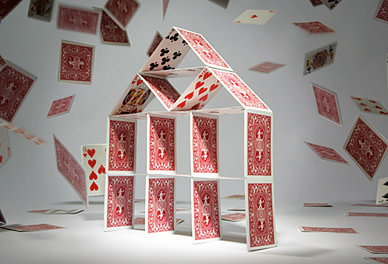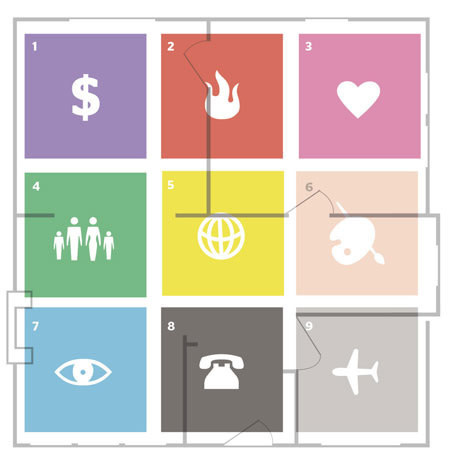House of Harmony

When the ancient Chinese wanted guidance in finding the most auspicious places to farm, build their houses, or bury their dead, they turned to an ancient divining system called feng shui (pronounced “fung shway”). Developed 3,000 years ago to protect people from harsh winds, rain, freezes, and falling rocks in the mountainous southwestern region of China, feng shui (which translates literally as “wind-water”) has evolved in the modern and Westernized world into a set of principles to guide architecture and home décor. But the philosophy’s basic presuppositions remain unchanged: chi (the Chinese word for energy) flows through us and everything around us, and every person, place, and thing has a vital life force.
“You’re the center point of your own universe,” says Anne Mansfield, owner of the Portland consultancy Moon Gate Feng Shui and former president of the International Feng Shui Guild. “Feng shui makes up layers of influence in you and around your life, starting with you, your car, your house, the neighborhood, the city, the bioregion, and so on. You have an impact on them, and they have one on you.” Indeed, you could easily spend a lifetime studying the deepest nuances of the art, but feng shui’s basic tenets are also simple enough to be incorporated into springtime cleaning and furniture rearranging rituals (and they may offer some small amount of insurance against falling rocks).
{page break}
Map the Bagua

If an area of your life is particularly unsatisfying, identifying its connection to specific areas in your home is the first step toward improving it. The main tool for determining this is the bagua, an energy blueprint of your living space that aligns your home’s physical structure with different aspects of your life. The bagua will act as a basic map of your home’s energy.
Sketch the floor plan of your home—a whole house, an apartment, or a single room—and align the bottom of the bagua (squares 7, 8, and 9) with your home’s main entryway. Parts of the bagua may land outside of the home, likely on a terrace, backyard, or sidewalk—these missing areas need to be defined rather than ignored. Planting a physical anchor, like a tree or sculpture, at the border of the missing area will recognize it as part of your home, even if it’s the domain of birds and bees.
Each of the nine gua is associated with a specific life situation and thrives on certain aesthetic elements. Try redecorating the gua that currently resonates with you, incorporating its preferred colors and shapes. Each life situation also corresponds with different functions of your home that are not necessarily related to the gua’s location. For example, the stove always represents wealth and abundance, whether it’s in your wealth corner or not—so be sure to keep it scrubbed!
Learn the Gua
1. Wealth and Prosperity
Stash some coins in a red pouch, install a fountain or images of water, or place an upward-sprouting plant in this area of your home. Make sure the kitchen stove and plumbing are in excellent shape—and put the toilet lid down already!
2. Fame and Reputation
Fire elements in this square, like lamps and the color red, will rev up your “it person” status. Be sure your home makes as excellent a first impression as you do—sweep the front stairs, dust off the door, and create a welcoming entry.
3. Love and Relationships
Buy gorgeous new sheets and a sexy framed photograph or sculpture. Ensure that each side of the bed has a side table, a lamp, and easy access.
4. Family
Make sure wood elements and the color green are represented well in this part of your home, clear work off the dining table, and fashion a comfy gathering place for your brood.
{page break}
5. Center/Earth
Promote stability in your life by embracing yellows and browns, pottery, or square, flat objects like rugs and tiles.
6. Creativity and Children
Golds, pastels, rounded objects, and symbols of what you desire will enhance the creative process, whether you’re hoping to give birth to art, work, or actual babies.
7. Self-Knowledge and Spirituality
Feather a nook in your nest for quiet reflection and clean all mirrors and windows to ensure that you’re seeing things—including yourself—clearly.
8. Career
Dark blues and blacks, glass, and irregular, wavy shapes can help set you on your life’s true path—as long as the actual path to your home is welcoming to opportunities that come a-knockin’.
9. Travel and Helpful Friends
Renew your passport, rid your home of negative chi, clean out your car and garage, and invite people into your life who can make it easier, whether a teacher, a landscaper, or a feng shui consultant.
Clear Clutter
Clutter is the most common source of stagnant chi: it lowers energy and vitality,sustains the presence of bad memories (or bad gifts), and causes disarray. Take a close look through your belongings, weighing what you want and what you need. It’s a process of “setting goals and making choices on inner truth,” says Mansfield. “When you release stagnant things from your life, it opens up possibility and creates a shift in your own energy so you’re more receptive to new things.” Common chi-diminishers are unfinished projects, damaged or ill-fitting attire, and anything that conjures up negative feelings—the dusty box of glue and paper from your bookbinding class five years ago, that expensive but painfully tight pair of jeans, or the inherited couch with the broken leg.
If you don’t love something or use it regularly, and if it doesn’t enhance your life, get rid of it—that even goes for family heirlooms. Send your paper, glass, and plastic clutter to the green recycling bins; sell old stacks of books to Powell’s Books (multiple locations); take old clothes to a consignment shop like Buffalo Exchange or donate them to Goodwill; and haul household goods to a charity like the Community Warehouse (2267 N Interstate Ave).
{page break}
Follow the Chi
Here are six quick and easy fixes that will have your home brimming with good chi.
Mirror Mirage
In addition to increasing a room’s light and revealing your stunning looks, mirrors double as a magical feng shui tool. Hung strategically on walls, mirrors can expand small spaces, activate rarely used areas, and, when facing an annoyance (like a neighbor’s incessantly barking dog), deflect negative energy. Placed above the stove, a mirror symbolically doubles your food and prosperity.
Curative Color
“A splash of color is a simple way to bring new energy into a space,” Mansfield says. “It’s the least expensive and easiest way to make a big impact.” Be careful to avoid using too much of one color in your home; using several colors helps balance the energy. A common feng shui practice is to paint a word on the wall that exemplifies what you want to bring into your life, like “friendship” or “travel.” Even if you paint over the word as you’re finishing the job, you’re embedding that energy into the room.

A Welcoming Center
Sprucing up the entry of your home will keep the good energy flowing inside. Keep the front door clean, the entryway clear of clutter—no piles of bills, shoes, or coats allowed—and add a welcoming greeter, like a healthy, round-leafed plant; an intriguing sculpture; or a Zen fountain.
Living Influence
Plants and animals will bring health and vitality into your home. Consider taking in pets or starting an aquarium for fish or amphibians—or choose the simpler route of easy-to-care-for plants like areca and lady palms.
Lighten Up
Lamps and candles enhance chi by illuminating choice spots instead of vast areas, creating intimacy. If you have low ceilings, buy lamps that shine upward. In the winter months or at night, candles warm up the home, as they represent the fire element, which balances out the water element (that frigid downpour outside).
A fundamental imperative of feng shui is that chi needs to be able to flow smoothly through a space. All doorways should lead to open paths in the home, without furniture or large objects obstructing that flow. Beware of energy impeders, or “poison arrows.” These dreaded darts include sharp-edged furniture, open bookshelves, and visible knife blades. (See “Follow the Chi,” right, for more quick fixes.)
We may live a long way from the perils of China’s mountains, but implementing feng shui can still bring serenity to your life. The practice recalls how the ancients lived and respects the ever-present power of nature and unseen energies—or at least gets the sharp furniture out of the way.
